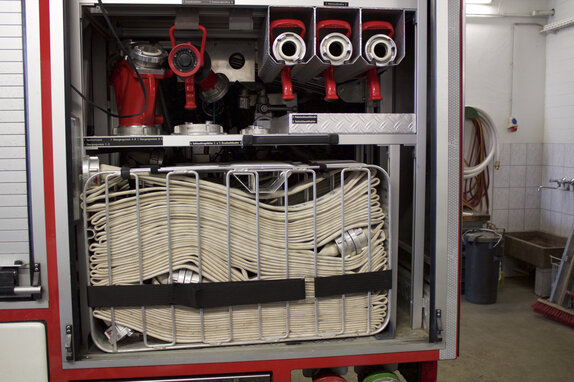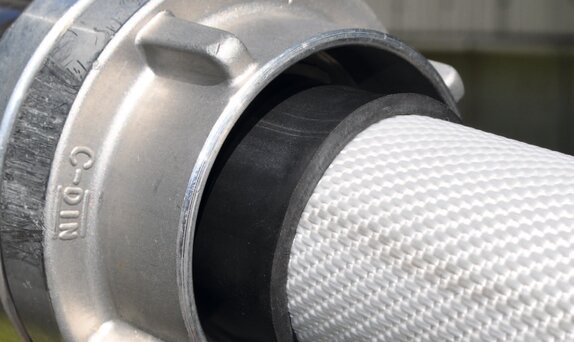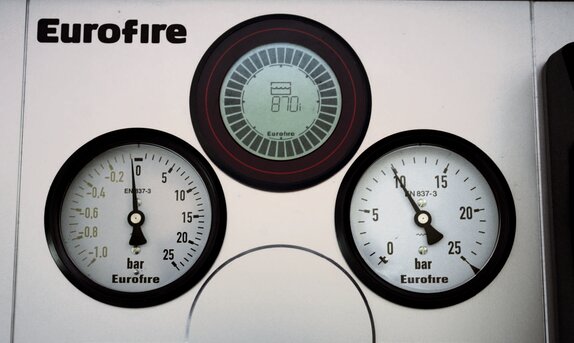Know how - 8 smart advices for long-lasting fire hoses
A hose pack is an essential piece of equipment in the fire truck. If it finds its place in the hose carrying basket, it should preferably be installed upright: When placed upright, the hose edge rubs less against the basket during travel - there are significantly fewer abrasion points than when transported lying down.
In addition, the surfaces of the hose carrier basket that are in contact with the hose should be checked regularly for sharp edges and burrs. This damage is caused by the mounted hose couplings. If you want to avoid this issue, use the GH Hose Package Carrying System!

Of course, a hose reel must be tightened to save space. However, this handle must never be done with the knee propped up or with a similarly high weight load:
At the places of operation, the ground is often rough (asphalt, pavement, etc.). Under the pressure load, damaging wear occurs on the edges of the hose.
What is the right way? If there are no smooth surfaces, the hose roll should only be tightened by hand with a light pull.

Fire hoses should always be laid without kinks. Unfortunately, this is not always the case right from the beginning. But why are kinks a big problem for the hose?
Kinks increase the pressure loss and reduce the flow rate! They are also one of the main causes of hose defects: due to the bulging of the hose at the kinked point, very strong point abrasion takes place there. If the hose moves additionally (retightening, spray shocks), this can lead to immediate failure even with new and high-quality fabric hoses.
Therefore: it is imperative to eliminate the kinks in the hose created during deployment as soon as personnel are freely available after the initial phase of the operation! And it is best to pay attention to the smallest bending radius when procuring the hose.

Packing the hose package on rough surfaces leads to high wear in the area of the hose edge and must be avoided at all costs. For this reason, only pack hose packages using the winding aids provided for this purpose (hose winding board) or on smooth surfaces. We recommend a heavy plastic tarpaulin or the smooth floor in the fire station for this purpose.

Damage to the coupling nozzle or in the binding area is one of the main reasons for hose failures. B hoses are particularly at risk due to the longer connection piece and the higher weight of the B pressure coupling. What is the remedy?
When purchasing a new hose, all hoses (including performance level 1) should be specified with a protective sleeve fitted. The small additional price provides a plus in safety for the emergency forces going ahead and significantly reduces annoying, expensive repairs to the hose collar.
When purchasing new fire hoses or repairing existing ones, make sure to use stainless steel wire for the hose cover. This has been prescribed by DIN since the end of 2014.

When laying fire hoses, watch out for broken glass, nails and other sharp objects. Why is this precaution important? Due to their design, even high-quality hoses are made of a textile fabric and therefore have limited resistance to cuts, punctures and abrasions.
Falling bricks and broken window panes pose similar hazards. Where operationally feasible, fire hoses should be routed in the debris shadow of buildings as little as possible during fires. Laying of hose lines through embers and fire should be avoided.

Partially emptied hoses are particularly sensitive due to their high weight and increased susceptibility to kinking due to lack of pressure. Therefore: Always empty the hoses completely before taking them back or pulling them!
In general, pulling - even of empty hoses - should be avoided. If winding on site is not possible, the hoses should be transported away in pens.

Not only hollow jet nozzles require a minimum pressure for proper function. Fire hoses should also be operated with at least 8 bar pump outlet pressure. Why is this so? Too low a pressure promotes kinking, which leads to premature wear, pressure losses and reduced flow rate.
